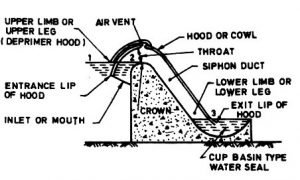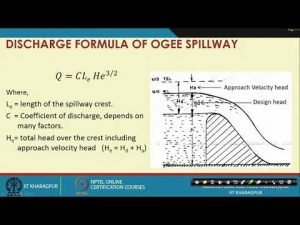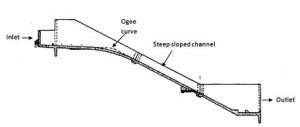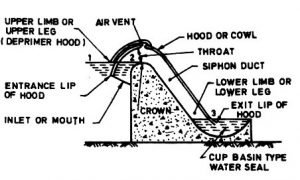What is Spillway & its 8 Types
A spillway is a structure used to provide the controlled release of water flows from a levee or dam into a downstream area, typically the river bed of the dammed river itself. They may be known as overflow channels. Spillways ensure that the water does not overflow the water and destroy or damage the dam.
We normally build a dam to hold a water store or back it for irrigation, hydropower, water supply, or flood control. But sometimes we have to let some water go for irrigation purposes. The impounded water behind the dam is simply too full to store water anymore. So whether we need it downstream, nearly every dam necessary a spillway to safely discharge water.

We understand spillways. We have to start with a hydrology circle. More specifically, we need to understand the tremendous variability in inflows that can affect reservoirs or dams. For example, designing a dam would be simple if snowmelt or rainfall were consistent throughout the year.
In fact, most dams wouldn’t even be needs, since the hydrologic variability system is the reason why most dams exist in the first place – to provide smooth out the ebbs and storage of water and so that water can be used to meet our needs throughout the year spikes of inflows to protect us from flooding or spikes of inflows to protect us from flooding. But, those spikes of inflow can be too much.
It’s not unusual for a watershed to generate most of its entire annual quantity of water in a single storm event. Water inflows can reach a reservoir with very little warning, so dams need to always be ready to handle major storm events of flow.
Types of spillway
Tunnel Spillway:
It discharges water through closed tunnels or channels under a dam or laid around. The closed channels can be in the form of an inclined or vertical shaft, a conduit constructed in a backfill with earth materials or an open cut, or a horizontal tunnel through rock or earth.
In narrow canyons with steep abutments and wide valleys with abutments far away from the stream canal, the spillways tunnel may prove to be advantageous. In such situations, the conduit can be easily located under the dam near the stream bed river.
Ogee (Overflow) Spillway:
It has a control weir. The upper spillway part of the surface matches closely to the profile of the lower nappe of a ventilated sheet of water falling down freely from a sharp-crested weir. It’s lower part of the surface is tangential to the supports of the falling sheet of water and the upper curve.

The end of the downstream is in the form of a reverse curve into the spillway discharge channel or turns the flow onto the apron of a stilling basin. Ogee is generally used for masonry and concrete dams. Ogee ideally suited to wider valleys where sufficient crest length may be provided.
Free Over-Fall Spillway:
Free overfall, the name, indicates the flow drops freely from the crest of the dam of a free over-fall spillway. At times, the dam’s crest is extended in the form of an overhanging lip to direct small discharges away from the face downstream of the overflow section. The falling water jet of the underside is properly ventilated so that the jet does not pulsate. Such a better-suited for a thin arch dam whose downstream face is nearly vertical.
Chute Spillway:
It is consists of an open channel through which the water discharges. For rockfill dams and earth dams, a separate spillway is generally constructed flank for saddle away from the dam if a suitable site exists.

Side Channel Spillway:
The control weir of a side-channel is located approximately parallel and alongside the upstream portion of the spillway discharge channel. It may be either a closed conduit or an open channel or an inclined tunnel. It’s discharge flow falls into a narrow trough and over the weir crest and takes an approximately 90° turn before continuing into the discharge channel.
Shaft Spillway:
It consists of a vertical shaft and a horizontal crest, with its lower end connected to a vertical shaft and its top surface at the crest level of the spillway. The other end of the vertical shaft is connected to a tunnel or a horizontal conduit, extending around or through the dam and carrying the water to the downstream river. It is used at the sites where the conditions are not favorable for chute or an overflow.
Siphon Spillway:
It operates on the principle of siphonic action. A Siphon is a closed conduit of the shape of an inverted U turn-tube with unequal legs. Siphon is commonly used in practice. The siphon duct is formed by an airtight Reinforced cement concrete cover, called a hood over an ogee-shaped body wall made of concrete.

Cascade Spillway:
It is used in this case of very high-level dams, the kinetic energy at the dam of the toe will be very high, and the tailwater depth in the river may not be adequate for a roller bucket stilling basin or single-fall hydraulic jump.
Curved and Narrow canyons consisting of fractured rock would not be suitable for trajectory buckets. In such situations, especially for rock-fill and high earth dams for which major structure of a spillway, the possibility of providing a cascade of falls with a stilling basin at each fall must be considered.
We Love Cricket